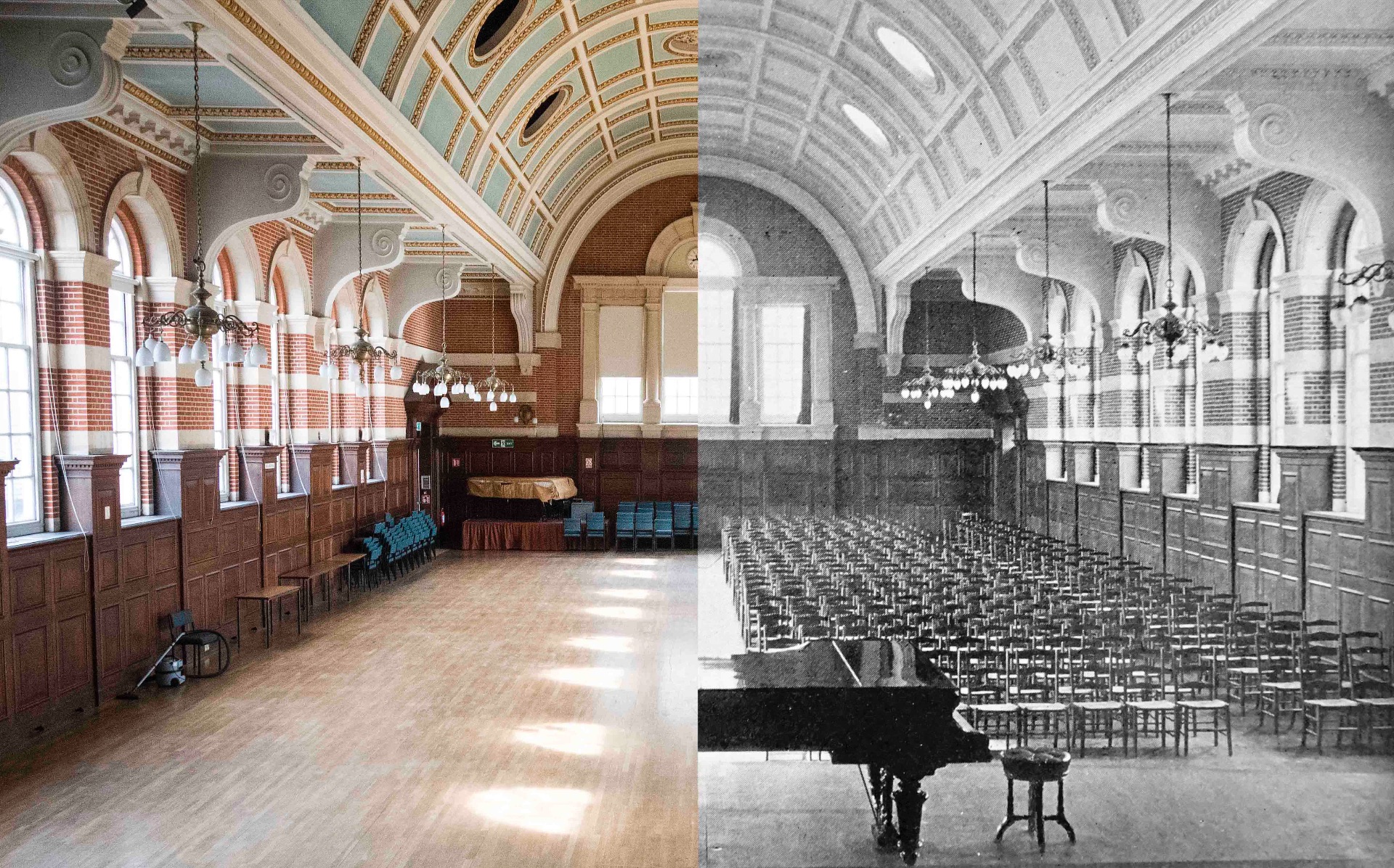The Times report of the grand opening of the Great Hall described it as ‘a handsome building‘. It is just as handsome today. It has been well maintained and beautifully preserved, and has been a Grade II listed building since 1987.

Architectural details can be found on the Historic England website. Here’s how the College Principal, W. M. Childs described it in his memoir:
‘A hall was built large enough to seat a thousand people. Externally, it was of a certain solidity; internally, the oak panelling, and the sweeping curves of the roof gave it a handsome and cheerful dignity. It answered its purpose as a rallying centre of life. Speakers and musicians praised it. Examinees found it comfortable and airy; for festivities it was first-rate; and its floor was very perfectly constructed for dancing.‘ (p. 56)
The dances have been described by several past students. Professor Holt reports an interview with Dr Adela Erith who had been a student in St Andrew’s Hall in 1913. According to Dr Erith the Warden, Miss Bolam, monitored the suitability of the men her charges wished to take to the summer ball: Were they gentlemen? Did they own a dinner suit?
‘She [Miss Bolam] would not countenance any unseemly behaviour and would not allow the men to swing the women off their feet when dancing the Lancers.‘ (Holt, 1977, p. 66)
Writing in 1949 Ernest Allwood, who had obtained the Diploma in Letters in 1920, wondered nostalgically:
‘How many present-day students can envisage a dance in the Great Hall with men in tails and white gloves and the women students being escorted by their duennas from their Hall of Residence in approved crocodile formation?’ (p. 26)
The one sour note about the Great Hall comes from the author and journalist Elspeth Huxley who arrived at Reading in 1925 to study agriculture. In her fictionalised autobiography, ‘Love among the Daughters‘, she describes the Hall as ‘a sort of outsize garden shed where dances, examinations and assemblies were held.‘ (p. 47).
This is just one of the many barbs she directs at the College and University, its campus and the area round London Road. She too reflects on the dancing and recalls her first Students’ Union dance at the beginning of the academic year. It is a sharp contrast to Childs’s description:
‘Tickets, so far as I remember, were three-and-six, including supper in the Buttery. The dances themselves were held in the outsize garden shed. The deal floor, rough and splintered and marked with ink stains from the pens of agonized examinees, was sprinkled for the occasion with french chalk which formed treacherous patches on which you were liable to slip and twist an ankle….Between dances, you walked about in cloisters swept by gusts of icy wind that wrecked you hair-do and chilled your bones.’ (Huxley, 1968, p. 51)
She didn’t think much of the supper in the Buttery either! Nevertheless, even the hard-to-please Elspeth Huxley had fond memories of such occasions: ‘And yet, we did enjoy those dances…. At eighteen, they had magic. God knows what one would think of them now.’ (pp. 51-2)
More evocative of my own experience of evening concerts in the Hall is ‘The Hall by Moonlight‘ by Allen Seaby. It was published in Tamesis, the College magazine in 1910. At the time he was Lecturer in Fine Art but became Director of the department in 1911 and Professor in 1920. He was a distinguished and prolific artist, author and ornithologist whose sketches and designs can be found in issues of the College Magazine, the College Review and other publications of the College and University. Further examples of Professor Seaby’s work will be featured in future posts.

2021
The references above mention dances, examinations, festivities, assemblies and concerts. But who would have predicted its deployment as a COVID-19 testing station?

Post Script
I shall return to Elspeth Huxley’s semi-fictionalised account of her time at Reading in a future post.
Thanks
I am grateful to Emily Gillmor for permission to reproduce ‘The Hall by Moonlight‘.
Sources
Allwood, E. F. (1949). 1919-1920. In H. C. Barnard (Ed.), The Education Department through fifty years (pp. 26-7). University of Reading.
Childs, W. M. (1933). Making a university: an account of the university movement at Reading. London: J. M. Dent & Sons Ltd.
https://historicengland.org.uk/listing/the-list/list-entry/1248715?section=official-listing
Holt, J. C. (1977). The University of Reading: the first fifty years. Reading: University of Reading Press.
Huxley, E. (1968). Love among the daughters. London: Chatto & Windus.
Nicholls, C. S. (2002). Elspeth Huxley: a biography. London: Harper Collins.
Seaby, A. W. (1910). The Hall by moonlight [Sketch]. Tamesis, Vol. X., Autumn Term, 1910. No. 1, between pp. 19 & 20.
University College, Reading. Speech by Mr Haldane. (1906, October 29). The Times, p. 3.
University College Reading (1908). Students’ handbook. Second issue: 1908-9. Reading: UCR.
University of Reading Special Collections, MS 5383/1-12 (Postcards): University Buildings, early 20th Century.

Priceless time capsules!